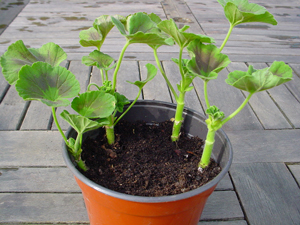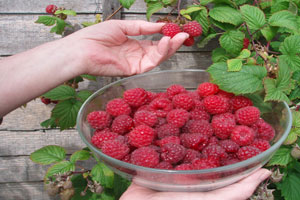May Garden Diary
Our May gardening diary is brought to you by Geoff Hodge of The Scotts Miracle-Gro Company – Lovethegarden.com
May is a busy time in the garden, getting everything ready for what will hopefully be a wonderful summer. Luckily, the days are getting longer and there are two Bank Holidays to enjoy and spend time gardening. The warmer temperatures provide great growing conditions, but frosts and cold nights are still possible, so keep an eye on any young and tender plants, which may suffer damage.
FLOWER BEDS & BORDERS
You can now plant out summer-flowering bulbs for a garden full of colour. These include tuberous-rooted begonias, cannas, dahlias, gladioli and lilies. Most prefer good, fertile soils and drainage, so prepare the soil first with lots of bulky organic matter, such as garden compost, composted bark, soil conditioner or planting compost. In poorly drained soils, it pays to put a 2.5cm (1in) thick layer of grit or gravel in the bottom of the planting hole to improve drainage.
If you need more half hardy, perennial patio and container plants to brighten up your garden this summer, you can propagate them from stem cuttings taken now.
 Take cuttings 7.5-10cm (3-4in) long, cutting just below a leaf joint, or node. Remove the leaves from the lower half to two-thirds of the stem and insert in pots of a suitable cuttings compost to the base of the leaves, spacing cuttings so the leaves don’t touch.
Take cuttings 7.5-10cm (3-4in) long, cutting just below a leaf joint, or node. Remove the leaves from the lower half to two-thirds of the stem and insert in pots of a suitable cuttings compost to the base of the leaves, spacing cuttings so the leaves don’t touch.
Place the pot in a plastic bag (except pelargoniums) or in a propagator with bottom heat of 21-24C (70-75F). Put them somewhere out of direct sunlight to root, and then pot up plants individually once they have rooted.
Young plants grown indoors with warmth will probably need hardening off –acclimatising them to the colder outdoor conditions – before planting outside. If not hardened off they can suffer a shock due to the wide deviation in indoor and outdoor conditions.
Hardening off usually takes 7-14 days and involves moving the plants from the heated structure to an unheated one, such as a cold frame, that is closed. Then open in the day and closed at night, then open all day, but the plants covered with horticultural fleece or similar material, before being finally exposed to the external conditions with no protection.
There’s still time to sow hardy annual seed outdoors where you want them to flower. For a really easy way of creating colourful annual flower borders, use Miracle-Gro Flower Magic. It is a 3-in-1 mixture of premium flower seeds, slow-release plant food that feeds the plants for up to four months and coir compost, which looks after the seeds and developing plants. There are three different colour mixes.
Spring bedding plants are finally coming to an end and you will probably need the space to plant out summer bedding from the end of this month or early June. So dig them up and prepare the soil ready for summer planting by adding lots of bulky organic matter.
Primroses and polyanthus are perennial and can be grown on for next year’s displays, so don’t throw them away. Tidy up the plants, removing dead and dying leaves and faded flower heads and, if necessary, split them into smaller plants. Then plant them up in pots big enough to take their roots and some fresh potting compost. Grow them on over the summer and plant them back out in their flowering positions in autumn.
Help plants that readily self seed, such as forget-me-nots (Myosotis), by sprinkling the seeds over the soil, or collect the seed for sowing later in summer for next year’s flowering plants.
Topical tip
Hardy annuals that were sown outside earlier in the year may need thinning out if sown too thickly. This is best done in two or three stages at fortnightly intervals. The final spacing should be between 23-30cm (9-12in) apart; the lower spacing for smaller plants and the upper one for tall or spreading plants.
PATIO GARDENING
As colourful displays from tubs, containers and hanging baskets are some of the most important summer garden features, it pays to pay attention to your patio and container plants now.
If your patio lacks structure, pot up long-term, permanent plants, such as small trees, shrubs – especially evergreens – herbaceous perennials and even fruit for a productive patio.
To get the best from all established plants, give them a good feed. Controlled-release or continuous-release feeds are excellent choices, as they release their nutrients as the plants need them and go on feeding for up to six months.
Check containers regularly and water whenever necessary to keep the compost evenly moist. Adding a water-retention gel to the compost will absorb water and act as a reservoir for plant roots, helping to reduce watering frequency.
If you have a greenhouse or similar protected structure, you can start planting up tubs and hanging baskets with summer bedding, ready to put out at the end of May or early June, whenever the fear of frosts has passed. Starting them indoors means they will come into flower earlier in the summer.
Topical tip
Watering is one of the biggest summer jobs and can take a lot of time. If you install an automatic drip watering system, it will do the watering for you – including when you go away!
LAWNS
Regular – at least weekly – mowing is a must now, as the grass will be growing fast. Good, regular mowing is important for achieving a quality lawn. Aim to keep the grass around 2.5-4cm (1-1½in) high. Raise the cutting height to 5cm (2in) in shady areas. A good mowing regime will encourage fine-leaved grasses – at the expense of coarser, weedier ones – and promote a thicker lawn that will discourage weeds and moss.
You can help lawns grow thicker and greener by applying a spring and summer lawn feed now. Both granular and liquid feeds are available – choose whichever you prefer.
Where weeds and moss are a problem, a triple-action feed, weed and mosskiller will feed and strengthen the grass and deal with both of these problems at the same time. Never rake out live moss from the lawn, as this will spread it and make it worse.
Keep lawn edges tidy by clipping them with long-handled lawn edging shears at least once a fortnight or, better still, after every mowing. Or fit edging strips around the lawn to prevent the grass creeping into the borders.
Topical tip
While you’re mowing, take note of any bare patches, moss and weeds and deal with any problems you see.
GROW YOUR OWN
Vegetables
Keep sowing fast-maturing vegetables, such as salads, little and often for a continuous supply of fresh crops throughout summer.
You can now sow tender vegetables, such as climbing French beans, runner beans, courgettes, squashes and marrows in 7.5-10cm (3-4in) pots of compost. At the same time, prepare the soil where these vegetables are going to crop. The soil needs to be enriched with lots of organic matter to improve the structure and the water-holding capacity, as these vegetables need plenty of moisture at the roots.
For great results, you could even dig a trench to a depth of 30cm (1ft) and fill it with organic matter, such as well-rotted garden compost, kitchen vegetable waste and even torn up newspaper and cardboard.
Sow cauliflowers and purple sprouting broccoli in a seedbed, for transplanting out into their final cropping position when they’ve developed five or six leaves. This will provide tasty autumn, winter and spring harvests.
Before sowing seeds outdoors or planting out young plants, give the soil a dressing of a general plant food, such as Growmore or fish, blood and bone to ensure strong plants and bumper crops.
Young Brussels sprout plants for next winter should now be ready for transplanting after early or mid-spring sowings. If you didn’t sow your own you can buy plants from garden centres. The quite large gaps between each plant can be used for quick maturing ‘catch-crops’, such as radishes, salad leaves and lettuces.
Topical tip
Broad beans and some other early crops need checking for aphids – greenfly and blackfly. Pinching out the tops of broad bean plants may deter the pest, but if they are already present, spray with an insecticide approved for the control of these pests on edible crops.
Fruit
 It’s not too late to plant all manner of container fruit trees and bushes, but they will need careful watering during warm and prolonged dry periods to ensure they establish quickly.
It’s not too late to plant all manner of container fruit trees and bushes, but they will need careful watering during warm and prolonged dry periods to ensure they establish quickly.
Mulching the soil around them with a 7.5-10cm (3-4in) thick layer of a suitable mulching material will help maintain soil moisture and keep weeds down.
Water and feed strawberries when they’re in flower. A couple of applications of a high potash liquid feed will ensure the plants produce an abundant crop. Don’t wait until the fruits are swelling, as too much extra water at that time will reduce the flavour potential.
Thin out crowded raspberry canes. This ensures there will be sufficient air and light between the stems to help reduce disease problems and ensure the plants can ripen all the young fruit to maturity. Carefully pull out unwanted raspberry suckers appearing between the rows and in pathways.
Topical tip
Cover soft fruit, especially strawberries and redcurrants, with netting to protect them from bird damage. If you grow a lot of soft fruit it might be worth investing in a fruit cage.
TREES, SHRUBS, ROSES & CLIMBERS
Deadhead azaleas, camellias and rhododendrons after flowering by carefully snapping off the dead flowers between thumb and forefinger, without damaging the growth buds below. Then feed with an ericaceous plant food to keep them growing well and ensure they produce lots of flower buds for next year.
Prune spring-flowering shrubs, such as Berberis, Chaenomeles, Forsythia and Ribes after flowering has finished. Remove one-third of the oldest flowering stems from Kerria and spring-flowering spirareas, such as Spiraea ‘Arguta’, and shorten the remaining flowered stems to a suitable sideshoot.
 Winter- and spring-flowering evergreens, such as Viburnum tinus, can also be cut back or trimmed this month after flowering. Prune out any frost-damaged shoots from affected evergreens and remove reverted, all-green shoots from variegated evergreens. Spring-flowering clematis species and their varieties can, if necessary, be pruned back at this time of year once they have finished flowering. These include C. alpina, C. macropetala and C. montana. Although it isn’t necessary or essential to prune them, because they are so vigorous and fast growing, they can quickly grow out of control. Cut back the flowered growth hard and tie in shoots evenly to cover their supports.
Winter- and spring-flowering evergreens, such as Viburnum tinus, can also be cut back or trimmed this month after flowering. Prune out any frost-damaged shoots from affected evergreens and remove reverted, all-green shoots from variegated evergreens. Spring-flowering clematis species and their varieties can, if necessary, be pruned back at this time of year once they have finished flowering. These include C. alpina, C. macropetala and C. montana. Although it isn’t necessary or essential to prune them, because they are so vigorous and fast growing, they can quickly grow out of control. Cut back the flowered growth hard and tie in shoots evenly to cover their supports.
After pruning, always apply a suitable granular feed, such as a rose feed, to encourage good growth that will flower well next year.
Carefully pull off suckers developing around the base of grafted trees, shrubs and roses. It is far better to pull them off rather than cut them off, as dormant buds can remain when cutting and these will grow and produce a thicket of further suckers.
Topical tip
Reverted all-green shoots on otherwise variegated evergreen shrubs should be cut out. If you leave them, they will take over the whole plant.
GENERAL GARDENING JOBS
Check plants regularly to see if they need watering. Established plants should be left to fend for themselves, but those in containers, growing close to walls and anything recently planted may be in need of a drink. It is far better to give one good soaking every seven to 10 days, rather than watering little and often, which only encourages surface rooting – making the plants more susceptible to drying out.
Frosts, cold nights and cold winds may all be possible this month, so make sure tender plants like young bedding plants, tomatoes and other tender vegetable plants are protected from damage. Always have horticultural fleece on hand, which can be thrown over the plants to give several degrees of cold and frost protection.
Topical tip
Keep on top of weeds as they appear by either hoeing regularly or spray them with a suitable weedkiller.
HOUSEPLANTS
Water indoor plants regularly as and when they need it. Check plants every few days and water if necessary. Most plants prefer to slightly dry out between watering, and overwatering is more of a killer than underwatering. Lifting up the pot and feeling the weight is one of the best ways to know if the compost is drying out and plants need watering. Or insert your index finger into the compost to see whether it feels moist. Keep houseplants growing and flowering well by feeding regularly throughout spring and summer with a liquid plant food.
If roots are appearing through the drainage holes in the base of pots, this is a great time to repot houseplants into a larger size. Flowering houseplants usually perform better if they are kept slightly pot-bound, but freshen them up by replacing the top 13mm to 2.5cm (½-1in) of old compost with fresh compost.
Topical tip
Check houseplants regularly for any pest problems on the leaves, stems and flowers. Deal with them promptly to prevent them getting out of control. Spraying with a systemic insecticide will kill existing pests and help protect against further outbreaks.
Use plant protection products & biocides safely. Always read the label and product information before use. Pay attention to the risk indications and follow the safety precautions on the label.
For full information on all Scotts Miracle-Gro products, visit lovethegarden.com
Products marked ® and ™, Miracle-Gro and Levington are trademarks of The Scotts Company LLC or its subsidiaries.



